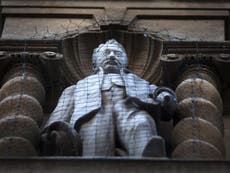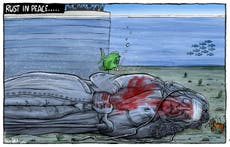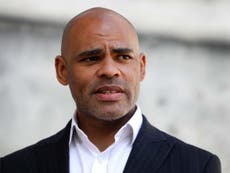The UK is crawling with monuments to slavery. The Robert Milligan statue in Tower Hamlets should be next to go
The longer it stays, the more complicit we’ll be in dismissing the legacies of people who put black people into the chains of bondage, including babies and children

On Sunday in Bristol, Black Lives Matter protesters pulled down a Grade II listed statue of Edward Colston, a 17th century slave trader, and pushed it into the harbour. Erected in 1895, the statue has long been a figure of controversy.
In my borough, outside the Museum of London Docklands at West India Quay, stands a statue of Robert Milligan, the merchant who was the driving force behind the creation of the West India Docks. Despite this achievement, Milligan owned two sugar plantations in Jamaica, which were worked by over 500 enslaved people. Born in 1746 and the son of a Dumfries shopkeeper, Milligan was always against the abolition of the slave trade until the day he died in 1809.
Liberal Democrat Federal Board Member, Elaine Bagshaw, who brought Milligan's statute to my attention said: “There’s no need for statues in public places that celebrate and venerate people that ripped thousands from their homes and traded them based on the colour of their skin. We can remember the slave trade without celebrating the perpetrators. It’s time for it to be removed.”
Regardless of our own personal views, most people would agree that using violence during a protest is not – and never will be – condoned. We cannot work together to promote inclusion, understanding and peace through aggression or destruction. If these statues are removed, it must be done legally.
When my father first came to England as a young man, he worked on the docks of the east end, which has a history of colonialism. The Lascars, seamen recruited by the British East India Company, were experts in seamanship, ship building and port activities, and most of the City of London was built on the transatlantic slave trade. They were given less food and were only paid five per cent of white sailors’ wages, despite being expected to work longer hours. They also played a significant role during wars, including the First World War.
As part of its education programme, the Museum of London Docklands displays information and stories about the transatlantic slave trade in its galleries and objects related to British colonial rule in Sierra Leone, but this will only be seen if one visits the museum.
The other side of the argument over removing statues is that if we remove these statues, will we be eradicating a part of history whether it was good or bad.
The alternative solution could be to leave the statues in situ, but erect a plaque or information stand that explains who these people were and how their behaviour essentially led to many of the issues we face today.
Nevertheless, while it is important to preserve history and culture, is it still necessary to keep statues that depict the exploitation of people? Since we allegedly live in a society that promotes equality, if statues representing people’s historical achievements are erected, then why are there no statues of enslaved people who rebelled against their slave masters and attempted to escape?
In 1831 in Jamaica, for example, more than 20,000 slaves seized control of the north-west corner of the island, setting fire to planters’ houses. It took the British Army and militia a month to restore order. The uprising resulted in the death of around 200 enslaved Africans and 14 white people, and at least 340 enslaved rebels were hanged or shot afterwards.
Roderick Lynch, chair of Liberal Democrat Campaign for Racial Equality, whose ancestors were enslaved people from the Caribbean paradise island of Saint Lucia, pointed out that his surname originates from a slave owner. He said: “We do not need statues of racist slave traders to remind us of the atrocities committed against black people. Erecting a statue of someone based on just one philanthropic act whilst forgetting the countless injustices for which they were responsible is, frankly, an insult. If you visit any of these statues, they mention nothing about the years of barbaric slavery.”
After the abolition of slavery, Britain paid millions in compensation to slave owners rather than those who were enslaved. We are talking about rewarding the people who put black people into the chains of bondage, including babies and children. Those who benefited from the enslavement of innocent and tortured individuals, do not deserve the honour of a statue. They should be reserved solely for those who perform heroic actions, those who bring about positive change and those who fight for peace, equality, and global unity.
Rabina Khan is a Liberal Democrat councillor for Shadwell in Tower Hamlets Council





Join our commenting forum
Join thought-provoking conversations, follow other Independent readers and see their replies